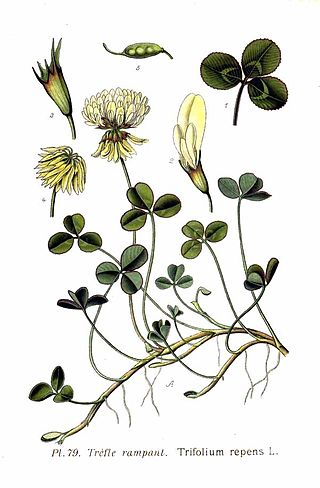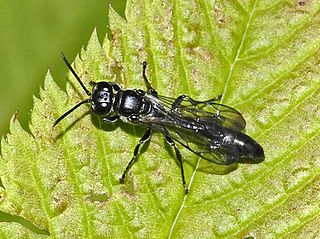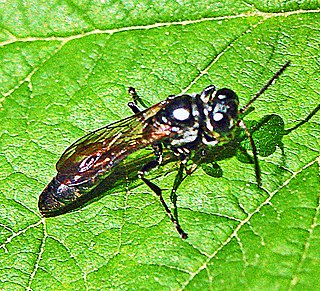
Clover, also called trefoil, are plants of the genus Trifolium, consisting of about 300 species of flowering plants in the legume family Fabaceae originating in Europe. The genus has a cosmopolitan distribution with highest diversity in the temperate Northern Hemisphere, but many species also occur in South America and Africa, including at high altitudes on mountains in the tropics. They are small annual, biennial, or short-lived perennial herbaceous plants, typically growing up to 30 centimetres (12 in) tall. The leaves are trifoliate, with stipules adnate to the leaf-stalk, and heads or dense spikes of small red, purple, white, or yellow flowers; the small, few-seeded pods are enclosed in the calyx. Other closely related genera often called clovers include Melilotus and Medicago.

The Credit River is a river in southern Ontario, which flows from headwaters above the Niagara Escarpment near Orangeville and Caledon East to empty into Lake Ontario at Port Credit, Mississauga. It drains an area of approximately 1,000 square kilometres (390 sq mi). The total length of the river and its tributary streams is over 1,500 kilometres (930 mi).

Chytridiomycosis is an infectious disease in amphibians, caused by the chytrid fungi Batrachochytrium dendrobatidis and Batrachochytrium salamandrivorans. Chytridiomycosis has been linked to dramatic population declines or extinctions of amphibian species in western North America, Central America, South America, eastern Australia, east Africa (Tanzania), and Dominica and Montserrat in the Caribbean. Much of the New World is also at risk of the disease arriving within the coming years. The fungus is capable of causing sporadic deaths in some amphibian populations and 100% mortality in others. No effective measure is known for control of the disease in wild populations. Various clinical signs are seen by individuals affected by the disease. A number of options are possible for controlling this disease-causing fungus, though none has proved to be feasible on a large scale. The disease has been proposed as a contributing factor to a global decline in amphibian populations that apparently has affected about 30% of the amphibian species of the world. Some research found evidence insufficient for linking chytrid fungi and chytridiomycosis to global amphibian declines, but more recent research establishes a connection and attributes the spread of the disease to its transmission through international trade routes into native ecosystems.

The four-toed salamander is a lungless salamander native to eastern North America. It is the only species of the monotypic genus Hemidactylium.
Acestridium is a genus of freshwater fish in the family Loricariidae of order Siluriformes. The type species is Acestridium discus. The genus name is derived from Latinised Greek 'agkistron' meaning hook.

Zodarion is a genus of ant-eating spiders from the family Zodariidae. 169 species from Eurasia, North Africa and North America have been described as of November 2022.
Oxyropsis is a genus of fish in the family Loricariidae native to South America. These species are distinguished by the presence of a single row of enlarged odontodes along the trunk midline lying adjacent and immediately dorsal to, the lateral line canal. Species of this genus have a depressed head and have relatively large eyes placed ventrolaterally. This genus is most similar to Hypoptopoma in external appearance, which shares the head shape and eye placement. Oxyropsis are elongate and have a narrow caudal peduncle, which distinguishes it from all other Hypoptopomatinae genera except Niobichthys and Acestridium.

Gilbertiodendron is a genus of legume in the family Fabaceae. It consists of about 25 species of tree native to west and west-central tropical Africa. Members of this genus were formerly considered to be in the genus Macrolobium but that genus is now restricted to species growing in tropical America. It is closely related to Pellegriniodendron.

Amblyomma is a genus of hard ticks. Some are disease vectors, for example the Rocky Mountain spotted fever in United States or ehrlichiosis in Brazil.
Centorisoma is a genus of frit flies in the family Chloropidae. There are at least 20 described species in Centorisoma.

Bayshore Blufflands State Natural Area is a Wisconsin Department of Natural Resources-designated State Natural Area of significant note for its grand scenery, unusual geology, rare plant and animal species. Containing more than 7 miles (11 km) of the Niagara Escarpment, the Bayshore Blufflands is an ecologically complex site with a diversity of plant communities both above and below the escarpment and a series of seeps and springs at the base of the bluff's talus slopes.
Galeosoma is a genus of African armored trapdoor spiders that was first described by William Frederick Purcell in 1903.
Zodarion scutatum is a spider species found in Slovenia and Croatia.

Trypoxylon is a genus of wasps in the family Crabronidae. All Trypoxylon species that have been studied so far are active hunters of spiders, which they paralyse with a venomous sting, to provide as food to their developing larvae. Depending on the species, they will either construct their own nest from mud or find cavities that already exist. These cavities can range from keyholes to nail holes to previously abandoned nests, and are generally sealed with mud to create cells for their larvae.
Prionosternum is a genus of Australian white tailed spiders that was first described by R. A. Dunn in 1951. As of May 2019 it contains only three species: P. nitidiceps, P. porongurup, and P. scutatum. Originally placed with the ground spiders, it was moved to the Lamponidae in 2000.

Trypoxylon scutatum is a predatory wasp in the family Crabronidae.
Acestridium gymnogaster is a species of armored catfish in the genus Acestridium, native to the Madeira River in Brazil.
Acestridium triplax is a species of armored catfish in the genus Acestridium. It is native to the Amazon River in Brazil.
Hypsilurus godeffroyi, also known commonly as the angle-headed lizard, the northern forest dragon, and the Palau tree dragon, is a species of lizard in the family Agamidae. The species is native to Palau and Papua New Guinea.









